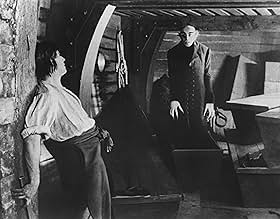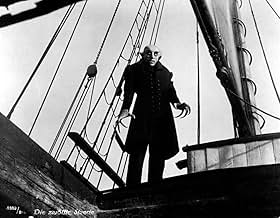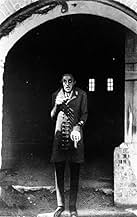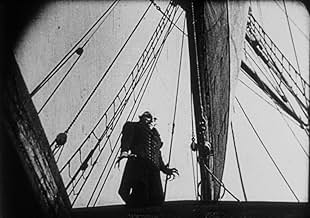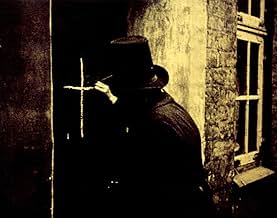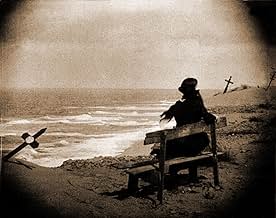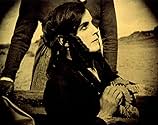Vampir Graf Orlok bekundet sein Interesse an einem neuen Wohnsitz, einschließlich der Ehefrau des Häusermaklers Hutter.Vampir Graf Orlok bekundet sein Interesse an einem neuen Wohnsitz, einschließlich der Ehefrau des Häusermaklers Hutter.Vampir Graf Orlok bekundet sein Interesse an einem neuen Wohnsitz, einschließlich der Ehefrau des Häusermaklers Hutter.
- Auszeichnungen
- 3 Gewinne & 2 Nominierungen insgesamt
Gustav von Wangenheim
- Hutter
- (as Gustav v. Wangenheim)
Greta Schröder
- Ellen - seine Frau
- (as Greta Schroeder)
Georg H. Schnell
- Harding - ein Reeder
- (as G.H. Schnell)
Karl Etlinger
- Kontrolleur am Kai
- (Nicht genannt)
Guido Herzfeld
- Wirt
- (Nicht genannt)
Hans Lanser-Ludolff
- A magistrate
- (Nicht genannt)
Loni Nest
- Child at Window
- (Nicht genannt)
Josef Sareny
- Head Coachman
- (Nicht genannt)
Fanny Schreck
- Krankenschwester im Hospital
- (Nicht genannt)
Eric van Viele
- Matrose 2
- (Nicht genannt)
Handlung
WUSSTEST DU SCHON:
- WissenswertesThe movie was banned in Sweden due to excessive horror. The ban was finally lifted in 1972.
- Patzer(at around 30 mins) When Hutter is writing his letter to Ellen in Count Orlok's castle, the paper that he is meant to be writing on is clearly blank throughout the scene.
- Zitate
Graf Orlok: Your wife has such a beautiful neck...
- Alternative VersionenThere are a confusing number of different surviving prints, restorations and alternate versions of Nosferatu. In the main, there are three 'complete' restorations and two incomplete, partially-restored versions. All five are available on DVD, while the latest two restorations, from 1995 and 2006, are also on Blu-ray. In addition there are countless low-quality public domain DVDs with different lengths, running speeds and soundtracks. All are derived from a single print held by the Museum of Modern Art (MoMA). They usually have replacement American intertitles and are always in black and white; the film was originally color tinted throughout and only meant to be seen that way. This comprehensive article explains all of them simply and clearly: Nosferatu: The Ultimate Blu-ray and DVD Guide.
- VerbindungenEdited into Boo (1932)
- SoundtracksJeux d'enfants - Galop
Written by Jack Norworth
[Plays during the croquet scene in the 2006 restoration]
Ausgewählte Rezension
Quite possibly my own very favourite movie. No vampire film before or since has been either as disturbing or as artful. Less overtly "expressionistic" than some of the other German films of the day, but no less visually impressive. Look at the seascape where Ellen/Nina/Mina pines over her departed husband. Watch those marvelous shadows, which we see in Bremen more often than the vampire itself, used especially effectively in the closing sequence.
And look at Max Schreck himself! While Bram Stoker gave his Count affinity with wolves and bats, Murnau favours that rat, both in that they surround him and that he physically resembles a shaved, cadaverous rat. Spreading his pestilence, Max Schreck is truly the vilest, most loathsome villain in the history of film. The scene where he rises suddenly erect from his coffin aboard ship is one that horror directors everywhere should study very carefully.
Nosferatu is also noteworthy as the origin of the idea that vampires are killed by sunlight, previously present neither in literature nor folklore. In response to the poster who complained that the vampire seems to be walking around in light before his death, these scenes are set at night. In the original versions, there was a blue tint over these scenes to let you tell night from day; it's difficult to tell the difference without them.
My copy is marred with some hilarious inappropriate sound effects (such as a massive "BOING" when the gates of the castle open on their own accord) which I've learned not to hold against the film itself.
Thank God that Florence Stoker did not manage to completely wipe this film of the face of existence.
And look at Max Schreck himself! While Bram Stoker gave his Count affinity with wolves and bats, Murnau favours that rat, both in that they surround him and that he physically resembles a shaved, cadaverous rat. Spreading his pestilence, Max Schreck is truly the vilest, most loathsome villain in the history of film. The scene where he rises suddenly erect from his coffin aboard ship is one that horror directors everywhere should study very carefully.
Nosferatu is also noteworthy as the origin of the idea that vampires are killed by sunlight, previously present neither in literature nor folklore. In response to the poster who complained that the vampire seems to be walking around in light before his death, these scenes are set at night. In the original versions, there was a blue tint over these scenes to let you tell night from day; it's difficult to tell the difference without them.
My copy is marred with some hilarious inappropriate sound effects (such as a massive "BOING" when the gates of the castle open on their own accord) which I've learned not to hold against the film itself.
Thank God that Florence Stoker did not manage to completely wipe this film of the face of existence.
Top-Auswahl
Melde dich zum Bewerten an und greife auf die Watchlist für personalisierte Empfehlungen zu.
Details
- Erscheinungsdatum
- Herkunftsland
- Offizieller Standort
- Sprachen
- Auch bekannt als
- Nosferatu
- Drehorte
- Starhrad Castle, Nezbudská Lúcka, Slowakei (Republik)(castle in ruins)
- Produktionsfirmen
- Weitere beteiligte Unternehmen bei IMDbPro anzeigen
Box Office
- Weltweiter Bruttoertrag
- 45.595 $
- Laufzeit1 Stunde 34 Minuten
- Sound-Mix
- Seitenverhältnis
- 1.33 : 1
Zu dieser Seite beitragen
Bearbeitung vorschlagen oder fehlenden Inhalt hinzufügen

Oberste Lücke
What is the Japanese language plot outline for Nosferatu, eine Symphonie des Grauens (1922)?
Antwort

